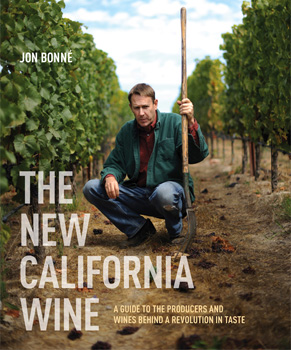

The New California Wine
Author: by Jon Bonné
Publisher: Ten Speed Press, 2013
Price: $35
When Jon Bonné moved to California in 2006 to become the wine critic for the San Francisco Chronicle, he found himself in a curious position: He was suddenly one of the most prominent voices on wine in California, yet he was routinely disappointed by the state’s wines. Too many producers, he felt, were locked in an arms race to produce increasingly ripe, opulent wines.
In The New California Wine, Bonné chronicles a wide range of emerging producers who nudged him from skepticism to optimism. As he explored the state’s wines, he writes, he began to notice a small but significant number of producers looking to the traditional Old World wines for inspiration. They were farming to maintain natural acidity and picking at moderate ripeness, avoiding manipulations in the cellar and relying less on new oak. Some were doing pioneering work with unusual grape varieties. Often they were seeking cooler, more marginal vineyard sites.
The New California Wine is largely a survey of these new-wave producers, people like Steve Matthiasson, a Napa viticulturist
who, under his own label, works with Italian varieties like tocai friulano and ribolla gialla. Or Ted Lemon of Littorai, who ran Domaine Guy Roulot in Burgundy before returning to California to make some of the most exciting, structured renditions of pinot noir from the far Sonoma Coast. As Bonné sees it, the glue that binds these winemakers into a coherent movement is “an ardent belief that place matters.” That’s a broad brushstroke—and some may take issue with it: Other winemakers, including those working in more brash, full-bore styles, would argue that they, in their own way, are concerned with terroir.
Practically speaking, the book ends up being as much about viticulture and winemaking style as about place itself, as Bonné tracks the ways in which these winemakers pursue wines of moderation in California’s abundant sunshine—entering conversations about yield management, cover cropping, dry farming, heritage vine material and rootstocks. The middle section of the book focuses most closely on place, devoting chapters to critically lauded regions (like the far Sonoma Coast) and to the potential of others (including the Sierra Foothills and Lodi).
With the goal of providing a comprehensive survey of the “New California,” Bonné ends up focusing more on how these producers make their wines than about the people themselves. As a result, it feels more encyclopedic than narrative.
The book’s clear strength is Bonné’s deep engagement with the forces shaping wine in California—he’s able to discuss everything from the impact of leaf roll virus on older vine material to the effect of California’s Prop. 13 voter initiative on vineyard property taxes. Part polemic and part reference, the book is a timely guide for wine buyers to a set of wineries that, on the whole, are indeed making some of the most exciting California wines right now.
Longtime senior editor at Wine & Spirits magazine, Luke now works for the Stanford Technology Ventures Program.
This story appears in the print issue of October 2013.
Like what you read? Subscribe today.
















